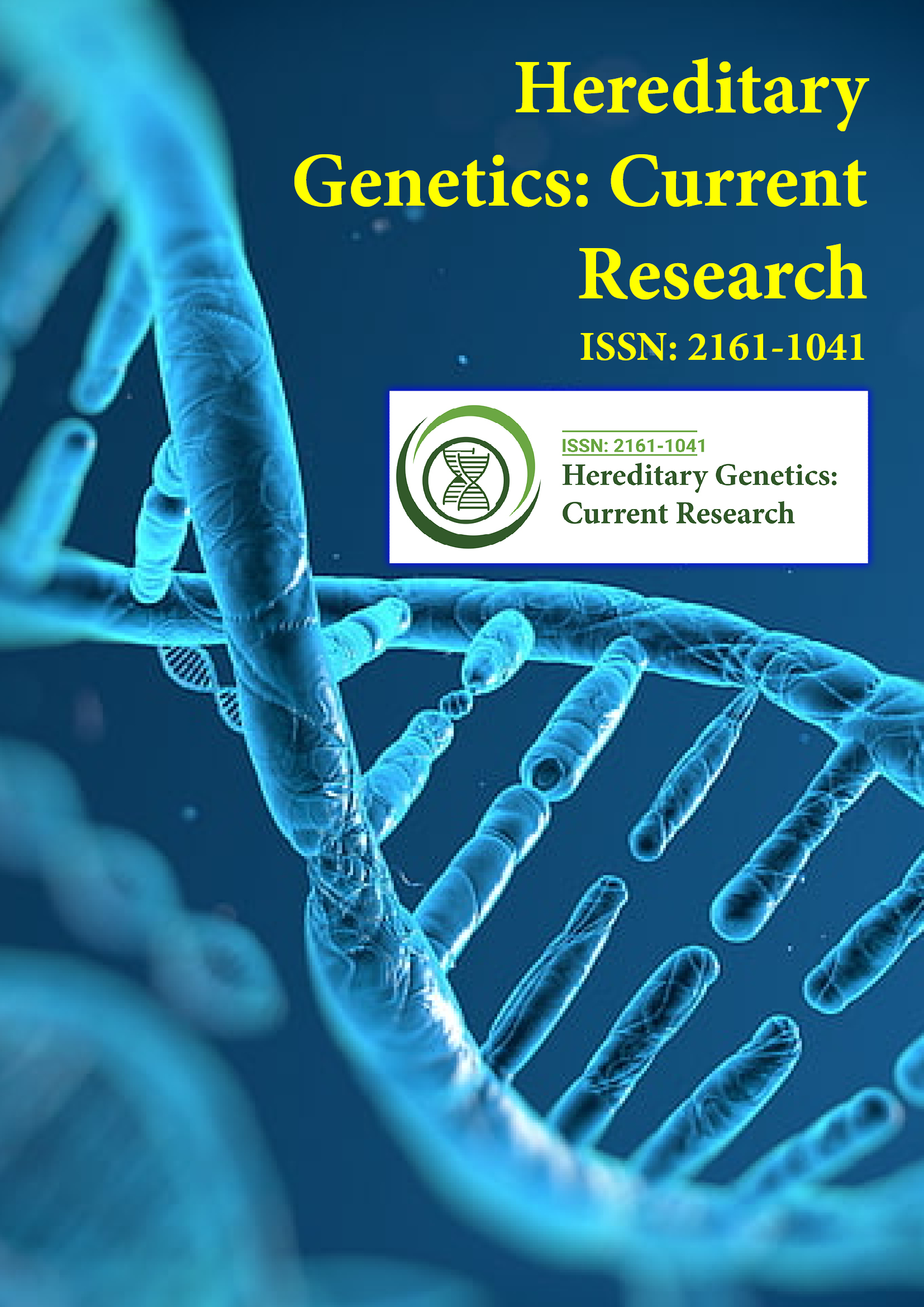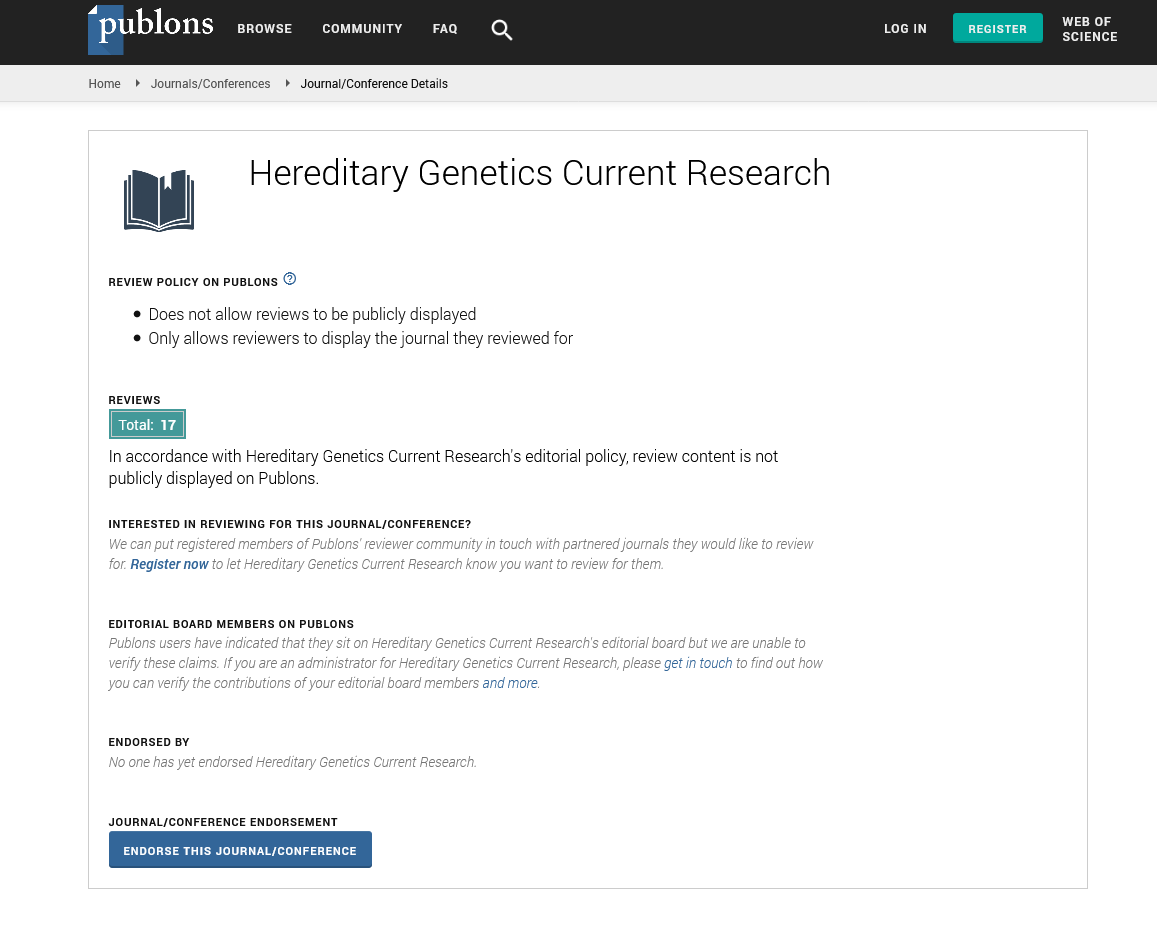Indexed In
- Open J Gate
- Genamics JournalSeek
- CiteFactor
- RefSeek
- Hamdard University
- EBSCO A-Z
- NSD - Norwegian Centre for Research Data
- OCLC- WorldCat
- Publons
- Geneva Foundation for Medical Education and Research
- Euro Pub
- Google Scholar
Useful Links
Share This Page
Journal Flyer

Open Access Journals
- Agri and Aquaculture
- Biochemistry
- Bioinformatics & Systems Biology
- Business & Management
- Chemistry
- Clinical Sciences
- Engineering
- Food & Nutrition
- General Science
- Genetics & Molecular Biology
- Immunology & Microbiology
- Medical Sciences
- Neuroscience & Psychology
- Nursing & Health Care
- Pharmaceutical Sciences
Short Communication - (2024) Volume 13, Issue 3
Inherited Diseases: Understanding the Genetics Behind Hereditary Conditions
Vinci Lendo*Received: 30-Aug-2024, Manuscript No. HGCR-24-28411; Editor assigned: 02-Sep-2024, Pre QC No. HGCR-24-28411 (PQ); Reviewed: 16-Sep-2024, QC No. QC HGCR-24-28411; Revised: 23-Sep-2024, Manuscript No. HGCR-24-28411 (R); Published: 30-Sep-2024, DOI: 10.35248/2161-1041.24.13.287
Description
Inherited diseases are disorders caused by abnormalities in an individual’s genetic makeup, passed down from one generation to the next. These conditions result from mutations or alterations in the DNA that can be inherited from one or both parents. The genetics behind these diseases is often complex, but understanding how they are inherited and their potential impact can help individuals take preventive measures, seek early diagnosis and manage health outcomes effectively [1-4].
Inherited diseases can generally be classified into three categories based on the manner in which they are passed on: Autosomal dominant, autosomal recessive and X-linked. Autosomal Dominant Inheritance: In this type, a single copy of a mutated gene from one parent is enough to cause the disease. This means that an affected individual has a 50% chance of passing the mutation to each of their children. Common examples of autosomal dominant diseases include Huntington's disease, Marfan syndrome and familial hypercholesterolemia [5,6].
Autosomal Recessive Inheritance: These diseases occur when an individual inherits two copies of the mutated gene, one from each parent. If both parents are carriers of a recessive gene mutation, there is a 25% chance their child will inherit the condition, a 50% chance of being a carrier and a 25% chance of inheriting two normal genes. Cystic fibrosis, sickle cell anemia and Tay-Sachs disease are examples of autosomal recessive conditions. X-linked Inheritance: These diseases are caused by mutations on the X chromosome. Since males have only one X chromosome, a single defective copy of a gene on this chromosome can result in the disease. In females, who have two X chromosomes, the defective gene must be present on both X chromosomes for the condition to manifest, though they can be carriers if they have only one defective gene. Hemophilia and Duchenne muscular dystrophy are classic examples of X-linked disorders [7,8].
At the molecular level, inherited diseases are typically caused by mutations in the genes that encode proteins necessary for normal cellular function. These mutations can occur in various ways, including point mutations, deletions, insertions, or chromosomal rearrangements. The resulting genetic abnormality can lead to the production of faulty proteins, which in turn disrupt normal cellular processes, leading to disease. Some inherited diseases, like cystic fibrosis, affect organs such as the lungs and digestive system, while others like sickle cell anemia impact blood cells. In other cases, the mutations may cause developmental issues or predispose individuals to certain cancers [9,10].
Advancements in genetic testing have revolutionized the understanding and management of inherited diseases. Through techniques such as genetic screening, doctors can identify genetic mutations before symptoms even appear, allowing for early interventions or preventive measures. For individuals with a family history of inherited diseases, genetic counseling can provide valuable information about the risks of passing on specific conditions to offspring. Carrier screening, particularly for recessive disorders, is becoming increasingly common for couples planning to have children. If both partners are carriers of the same autosomal recessive condition, they may opt for prenatal testing or assisted reproductive technologies like Preimplantation Genetic Diagnosis (PGD) to reduce the risk of having a child with the disease.
Conclusion
Inherited diseases are a significant aspect of human health, with a wide range of conditions caused by genetic mutations passed down through families. Understanding the different inheritance patterns, the mechanisms behind these diseases and the potential for genetic testing can empower individuals to make informed decisions about their health. With continued advancements in genetic research, the future offers hope for better treatments and even potential cures for many inherited diseases, ultimately improving the quality of life for affected individuals.
References
- Wu J, Jin S, Gu C, Wei Y, Zhu Y, Necchi A, et al. Inherited mutations in Chinese patients with upper tract urothelial carcinoma. Cell Rep Med. 2023;4(1).
- Rustgi SD, Ching CK, Kastrinos F. Inherited predisposition to gastric cancer. Gastrointest Endosc Clin N Am. 2021;31(3):467-487.
- Botto C, Rucli M, Tekinsoy MD, Pulman J, Sahel JA, Dalkara D. Early and late stage gene therapy interventions for inherited retinal degenerations. Prog Retin Eye Res. 2022; 86:100975.
- Lynch PM. History of hereditary nonpolyposis colorectal cancer or “lynch syndrome”. Revista Medica Clinica Las Condes. 2017;28(4):500-511.
- Diehl KA, Asif SK, Mowat F. Ophthalmic Disease and Screening in Breeding Dogs. Vet Clin North Am Small Anim Pract. 2023;53(5):965-983.
- Govers BM, van Huet RA, Roosing S, Keijser S, Los LI, Den Hollander AI, et al. The genetics and disease mechanisms of rhegmatogenous retinal detachment. Prog Retin Eye Res. 2023;97:101158.
- Chockalingam P, Wilde AA. Inherited arrhythmia syndromes leading to sudden cardiac death in the young: A global update and an Indian perspective. Indian Heart J. 2014;66:49-57.
- Pinheiro H, Oliveira C, Seruca R, Carneiro F. Hereditary diffuse gastric cancer-Pathophysiology and clinical management. Best Pract Res Clin Gastroenterol. 2014;28(6):1055-1068.
- Korczeniewska OA, Dakshinamoorthy J, Prabhakar V, Lingaiah U. Genetics affecting the prognosis of dental treatments. Dent Clin North Am. 2024;68(4):659-692.
- Ng BW, Kaukonen MK, McClements ME, Shamsnajafabadi H, MacLaren RE, Cehajic-Kapetanovic J. Genetic therapies and potential therapeutic applications of CRISPR activators in the eye . Prog Retin Eye Res. 2024;101289.
[Google Scholar] [Crossref] [PubMed]
Citation: Lendo V (2024). Inherited Diseases: Understanding the Genetics Behind Hereditary Conditions. Hereditary Genet. 13:287.
Copyright: 2024 Lendo V. This is an open access article distributed under the terms of the Creative Commons Attribution License, which permits unrestricted use, distribution and reproduction in any medium, provided the original author and source are credited.

